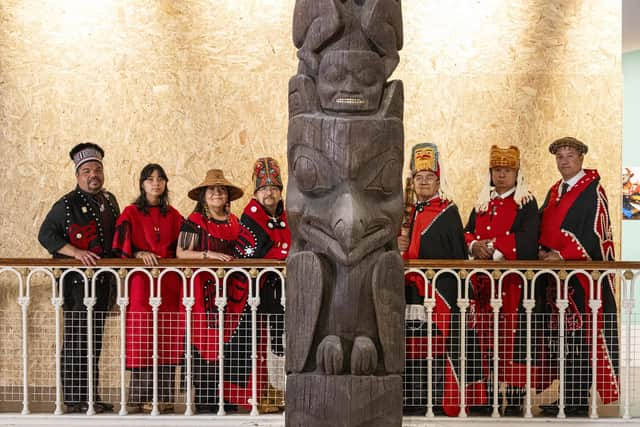Totem pole returning to Canada from Scotland ‘turns the colonial gaze onto itself’, campaigners say
It is a totem pole with huge spiritual significance for the indigenous population of Canada from whom it was taken more than a century ago.
But now the return of the Nisga'a totem pole, which is set to be transported from National Museums Scotland (NMS) to British Columbia in a military plane, is being hailed as not only a victory for the Nisga'a Nation, but for all campaigners fighting to have artefacts returned to their native countries – putting further pressure on institutions to return disputed objects to their native lands.
Advertisement
Hide AdAdvertisement
Hide AdDr Amy Parent, the Canada research chair in indigenous education and governance at Simon Fraser University in Vancouver who has led the move to return the pole, said its removal back to Canada “turns the colonial gaze onto itself”.


Along with other western institutions, Scottish museums have come under pressure in recent years to restore items to the countries where they were originally made – after being taken by colonialists and sold, or donated, to institutions in the UK.
“We are grateful to collectively tell a new story that turns the colonial gaze onto itself by acknowledging the complexities of our pole’s theft, its intergenerational absence from our community and the persistence needed to ensure that justice for our ancestors prevails,” said Dr Parent, who has the Nisga'a cultural name Noxs Ts'aawit.
"This new story also highlights the responsible commitments made by many who have demonstrated to our global community that it is possible to do the right thing by returning our ancestors, cultural treasures and belongings back to us, their rightful relatives.”
The Ni’isjoohl Memorial Pole was carved from red cedar in 1855 by artist Oyea Tait and his assistant carver, Gwanes, in memory of Ts’aawit, a Nisga’a chief. Nisga'a researchers say the pole, which was sold to the museum by Canadian anthropologist Marius Barbeau in 1929, was stolen without consent while locals were away from their villages for the annual hunting season.
The museum believes it acted in good faith, but now understands the individual who "sold" it to Mr Barbeau did so "without the cultural, spiritual, or political authority to do so on behalf of the Nisga'a Nation".
Last year, Glasgow Museums agreed to return seven stolen artefacts to India.
Six of the items, including 14th-century carvings and 11th-century stone door jams, were stolen from shrines and temples in the 19th century. Meanwhile, the seventh object, a ceremonial sword and its scabbard was stolen in 1905 from the collection of the Nizam of Hyderabad by his prime minister and then sold to the British general Sir Archibald Hunter. All of the artefacts were gifted to Glasgow Museums.
Advertisement
Hide AdAdvertisement
Hide AdNMS said it has only one outstanding request for the return of an item in its collection.
A spokesman said the museums were “considering” a request to transfer its Benin Bronzes, taken from the West African nation by British troops during an 1897 raid on the royal palace of Benin, which were later sold to the museum.
As a member of the Benin Dialogue Group, NMS says it is “committed to the reunion of these artworks through loans” to a new museum being built in Benin City, Nigeria. However, a permanent return would have to be approved by the Scottish Government.
Meanwhile, four years ago, the NMS was asked by the Egyptian government to produce certification documents for its Egyptian antiquities after a row broke out over plans to display a casing stone from the Great Pyramid of Giza.
Perhaps the most well-known disputed artefact is the Elgin Marbles. A-near 200-year battle over the objects – which were destined for the Scottish home of peer Lord Elgin, who took them from the Parthenon in Athens and subsequently sold them to the British Museum – has continued between the British and Greek authorities and still remains unresolved.
NMS director Dr Chris Breward said: “Since the transfer of the memorial pole was agreed last December, our teams have been planning the complex task of carefully lowering and transporting it in what is the first return of its type by a UK national institution. We are pleased to have reached the point where that work is now underway, and we are delighted to have welcomed the Nisga’a delegation to the Museum before we bid the pole farewell.”
The Scottish Government’s external affairs secretary, Angus Robertson, said: “The great significance of the Ni’isjoohl memorial pole to the Nisga’a people and their community was made clear to me when I met with their representatives last year and I was pleased to have been able to provide the necessary ministerial consent to enable its return.
“Today’s ceremony is the next step in that journey, following months of careful planning and dialogue between National Museums Scotland and the Nisga’a Nation, and I’m grateful to all parties for the work that has been undertaken to make it happen.”
Comments
Want to join the conversation? Please or to comment on this article.
